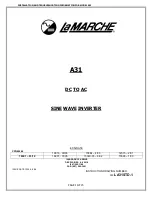
Output Amplifier and DC Offset
The signal passes via the Amplitude control VR27 to the output amplifier. A simplified diagram is
shown in fig. 7 and the following circuit description refers to this.
The HF amplifier is made up of discrete components and is in principle an inverting operational
amplifier with a gain of -10 set by R109 and R115. This has offset voltages and currents which are
compensated for by IC19 and IC20. IC19 compensates for input bias currents. IC20 controls dc
offset and LF gain by driving the non-inverting input.
Refer now to fig. 8 for the description of the HF amplifier (simplified). Q24 and Q26 are
complementary emitter followers to provide low drive impedance to the complementary class A
amplifier stage Q28 and Q29. Level shifting is achieved by adjustable zener diodes, these are
formed by a zener diode and a VBE multiplier. Note incorrect setting of the level shifters will cause
excessive current to flow in the class A stage causing damage to these devices. Refer to the
calibration section for adjustment procedure. The output of the amplifier stage is buffered by
complementary emitter followers Q30 and Q31 to drive the 50 Ohm output, D17 and D18 provide
their bias.
The non-inverting input is effectively the emitters of the class A amplifier, D19 and D20 provide the
necessary level shifting.
12














































